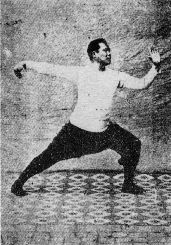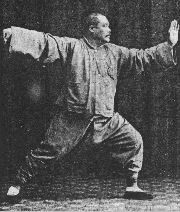copyright
© 2007 Tim Chan See Meng, all rights reserved
I recall a period of time when there was a diabolical debate over the
exact angle of the rear foot relative to the rest of the body position.
For instance, many diverse views were shared on the change in foot
stance of Yang Chengfu from his hey days to the latter years. One
interesting comment that struck me was if it feels good or comfortable,
then it is probably right. Similarly, there was also a time when many
questioned whether one should consciously tuck in the coccyx when one
performs the Tai Chi routine. One advice that came out of the public
forum was to try it out - if it doesn’t feel natural then one is doing
it incorrectly.
 Yang Chengfu, circa 1918
Yang Chengfu, circa 1918
 Yang Chengfu, latter years
Yang Chengfu, latter years
While these suggestions may sound logical and pragmatic, it can be
quite daunting, especially for a beginner to appreciate what is natural
or comfortable. For a start, if one is a beginner, all the movements
are naturally unnatural and uncomfortable. Some notable characteristics
of Tai Chi movements are relaxation ( 松腰 ), continuity ( 相連不斷 ),
focused and meditative ( 用意不用力).
If it is an essential principle to tuck in the coccyx and yet one has
to deliberately ensure this is maintained throughout the routine, I
would be surprised if one can stay relaxed, focused and rooted to the
ground for long. In such a situation, perhaps we should ask ourselves
whether the principle is wrong or the Tai Chi Chuan (TCC) routine we
are practicing is flawed. My point is taking the empirical approach
alone by trying things out on trial and error basis is not going to
take us far in resolving any of the above issues. Instead of just
gauging whether we feel good or natural, we should find out the ‘why’
which I feel is equally important, if not more.
Recently, it has come to my attention that some practitioners are
questioning whether the upper torso and head should be upright,
perpendicular to the ground. Videotapes and even drawings of great
masters like Yang Chengfu, Yang Sau Chong and Dong Ying Chieh have
shown otherwise. My teacher, master Dong Ying Chieh certainly never
taught me to assume this upright position. Master Yang Chengfu
emphasized that one should sink the chest and pluck the back ( 含胸拔背
),and straighten the head ( 虛靈頂勁 ).This leaves us to wonder whether
these principles have been misunderstood and exaggerated in the forms.
Let alone whether it is natural or not, I find it personally quite a
challenge to fully sink the chest and pluck the back at the same time
if one has to assume the upright perpendicular position.
Master Yang Luchan ( 楊露禪), and the second-generation masters are no
longer around to elucidate the principles of the art. However, what
they have left behind is their valuable insights captured in a few
literary books known today as the Tai Chi classics. These masters had
no qualms about putting the art to the test, eager to challenge and be
challenged. It was a reality check that ensured the effectiveness of
the art. Technology was not on their side to allow them to prove or
refine the art in a more scientific way.
We live in a different world today. We are more restrained and much
less inclined, for various reasons, to using the same approach as these
masters. However, I still look forward to seeing a TCC master
participating in the Japan K1 fight. That said, we should be looking
for a less violent and more structured approach to understanding the
art. And I find we can achieve this objective by expounding Chinese
wisdom through Western science such as relying on the discipline of
physiology and mechanics. In fact, many have already done so and I feel
a more systematic research and experiments can be done, documented and
shared with all ardent practitioners of the art. I am not an expert in
these scientific disciplines, but suffice to say it has helped
explained clearly some of the amazing feats I have witnessed in TCC.
My teacher Dong Ying Chieh constantly reminded me to move the waist
(Yiao) and not the hip girdle (Kwa) to guide the shoulders. Otherwise,
the twisting action is exaggerated and one loses core stability. If I
had not known what make up the Kwa and the associated range of waist
motion it supports, I would have a difficult time in correcting and
convincing my students.
Let’s consider a spring coil that is compressed tightly as depicted in
the diagram below. An inward force from the wall equally balances the
inward force from the compression. This creates inertia within the
coil. When the spring is released, acceleration creates a net outward
‘explosive’ force. This is shown in the diagram where the coil springs
forward.

How is this applicable in the context of Tai Chi fa-jing? Imagine the
wall is the solid ground and the coil represents the human body. We
need a solid base to assist in providing the forward thrust and this is
none other than mother earth, the solid ground that we are constantly
reminded to stay rooted via our legs. Even in executing a flying kick,
we need the ground to provide the initial lift to the air.
When an opponent pushes, the force is absorbed and neutralised by
transferring the impact to the ground through the feet. The absorbed
force, added on with our own force, is then returned to the opponent.
This is done using the supporting muscles and tendons to create a
sudden rebound, a split second repulse action. Of course, we still have
to rely on the ground to provide the backward thrust to maintain our
balance.
Call it the wonders of God’s creation, evolution or whatever; the
different parts of the body, such as the spine, are the way they are
for good reasons. The entire skeletal structure is held together and
supported by muscle tissues and tendons of various shapes and sizes.
Hence, if we want our body to be like a spring coil, we need to
understand the best angle to position our legs, hands, torso and the
associated muscle groups to use in order to attain the right body
alignment to counter an incoming force through absorption, deflection
or repulsion. In this regard, we can gain valuable insights from modern
science.
And let us not forget the ultimate principle that the mental, physical
and spiritual must move as one, in total unison. Once, we understand
with the help of modern science, we are one significant step closer to
the truth.
This is my layman attempt in using universal law of physics to explain
the phenomenon of fa-jing. I hope this will kindle the interest of
readers to use this mode of investigation to seek a more logical
explanation to many principles of TCC, some of which have been
mentioned earlier.


